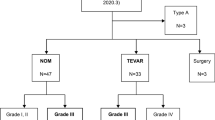Abstract
Objectives
Computed tomography (CT)-defined anatomical differentiation of minor and major blunt traumatic aortic injuries (TAIs) was applied to determine injury grade and management/outcomes in minor TAIs, and if the presence of peri-aortic mediastinal haematoma (MH) correlated with TAI grade.
Methods
Admission chest CT of blunt TAI cases during 2005–2011 were reviewed by consensus and categorised as major or minor. Minor was defined as pseudoaneurysm <10 % normal aortic lumen, intimal flap or contour abnormality. Presence/absence of MH was determined. Clinical management/outcome was ascertained from medical records.
Results
Of 115 TAIs, 42 were minor (33 with MH, 9 without). Among the 73 with major TAI, 3 had no MH. Twenty-six (62 %) minor TAI patients were managed medically, 12 (29 %) percutaneous stent-grafts, 2 (5 %) died of non-aortic causes and 2 (5 %) underwent surgery. Of 26 managed without intervention, none developed complications from TAI at last clinical or CT follow-up. The relationship between presence/absence of peri-aortic MH and grade of TAI was statistically significant.
Conclusions
More than a third of multi-detector (MD) CT-diagnosed TAIs were minor. Minor TAIs treated medically were stable at last follow-up, suggesting this is a reasonable initial management approach. Absence of MH cannot be relied upon to exclude minor TAI, indicating the need for careful direct aortic inspection.
Key Points
• MDCT can differentiate minor from major blunt traumatic aortic injuries.
• About one-third of MDCT-diagnosed blunt traumatic aortic injuries are minor.
• Minor aortic injuries are not necessarily accompanied by mediastinal haemorrhage.
• MDCT diagnosis of minor aortic injury supports application of medical management.






Similar content being viewed by others
References
Bertrand S, Cuny S, Petit P et al (2008) Traumatic rupture of thoracic aorta in real-world motor vehicle crashes. Traffic Inj Prev 9:153–161
Teixeira PG, Inaba K, Barmparas G et al (2011) Blunt thoracic aortic injuries: an autopsy study. J Trauma 70:197–202
Pearson R, Philips N, Hancock R et al (2008) Regional wall mechanics and blunt traumatic aortic rupture at the isthmus. Eur J Cardiothorac Surg 34:616–622
Siegel JH, Belwadi A, Smith JA, Shah C, Yang K (2010) Analysis of the mechanism of lateral impact aortic isthmus disruption in real-life motor vehicle crashes using a computer-based finite element numeric model: with simulation of prevention strategies. J Trauma 68:1375–1395
Patel HJ, Williams DM, Upchurch GR Jr, Dasika NL, Deeb GM (2009) A comparative analysis of open and endovascular repair for the ruptured descending thoracic aorta. J Vasc Surg 50:1265–1270
Simeone A, Freitas M, Frankel HL (2006) Management options in blunt aortic injury: a case series and literature review. Am Surg 72:25–30
Patel NH, Stephens KE, Mirvis SE, Shanmuganathan K, Mann FA (1998) Imaging of acute thoracic aortic injury due to blunt trauma: a review. Radiology 209:335–348
Riesenman PJ, Brooks JD, Farber MA (2012) A review of 100 consecutive cases of acute blunt traumatic thoracic aortic injury to the descending thoracic aorta. J Vasc Surg 56:1274–1280
Holmes JH 4th, Bloch RD, Hall RA, Carter YM, Karmy-Jones RC (2002) Natural history of traumatic rupture of the thoracic aorta managed nonoperatively: a longitudinal analysis. Ann Thorac Surg 73:1149–1154
Mosquera VX, Marini M, Lopez-Perez JM et al (2011) Role of conservative management in traumatic aortic injury: comparison of long-term results of conservative, surgical and endovascular treatment. J Thorac Cardiovasc Surg 142:614–621
Aladham F, Sundaram B, Williams DM, Quint LE (2010) Traumatic aortic injury: computerized tomographic findings at presentation and after conservative therapy. J Comput Assist Tomogr 34:388–394
Starnes BW, Lungren RS, Gunn M et al (2012) A new classification scheme for treating blunt aortic injury. J Vasc Surg 55:47–54
Paul JS, Neideen T, Tutton S et al (2011) Minimal aortic injury after blunt trauma: selective nonoperative management is safe. J Trauma 71:1519–1523
Malhotra AK, Fabian TC, Croce MA et al (2001) Minimal aortic injury: a lesion associated with advancing diagnostic techniques. J Trauma 51:1042–1048
Pate JW, Gavant ML, Weiman DS, Fabian TC (1999) Traumatic rupture of the aortic isthmus: program of selective management. World J Surg 23:59–63
Gavant ML (1999) Helical CT grading of traumatic aortic injuries: impact on clinical guidelines for medical and surgical management. Radiol Clin of N Am 37:553–574
Azizzadeh A, Keyhani K, Miller CC et al (2009) Blunt traumatic aortic injury: initial experience with endovascular repair. J Vasc Surg 49:1403–1408
Hartley MC, Langan EM 3rd, Cull DL et al (2009) Evaluation of the diameter of the proximal descending thoracic aorta with age: implications for thoracic aorta stent grafting. Ann Vasc Surg 23:639–644
Cleverley JR, Barrie JR, Raymond GS, Primack SL, Mayo JR (2002) Direct findings of aortic injury on contrast-enhanced CT in surgically proven traumatic aortic injury: a multi-centre review. Clin Radiol 57:281–286
Creasy JD, Chiles C, Routh WD, Dyer RB (1997) Overview of traumatic injury of the thoracic aorta. Radiographics 17:27–45
Wong H, Gotway MB, Sasson AD, Jeffrey RB (2004) Peri-aortic hematoma at diaphragmatic crura at helical CT: sign of blunt aortic injury in patients with mediastinal hematoma. Radiology 231:185–189
Akins CW, Buckley MJ, Daggett W, Mcllduff JB, Austen GA (1981) Acute traumatic disruption of the thoracic aorta: a ten-year experience. Am Thorac Surg 31:305–309
Author information
Authors and Affiliations
Corresponding author
Rights and permissions
About this article
Cite this article
Forman, M.J., Mirvis, S.E. & Hollander, D.S. Blunt thoracic aortic injuries: CT characterisation and treatment outcomes of minor injury. Eur Radiol 23, 2988–2995 (2013). https://doi.org/10.1007/s00330-013-2904-0
Received:
Revised:
Accepted:
Published:
Issue Date:
DOI: https://doi.org/10.1007/s00330-013-2904-0




